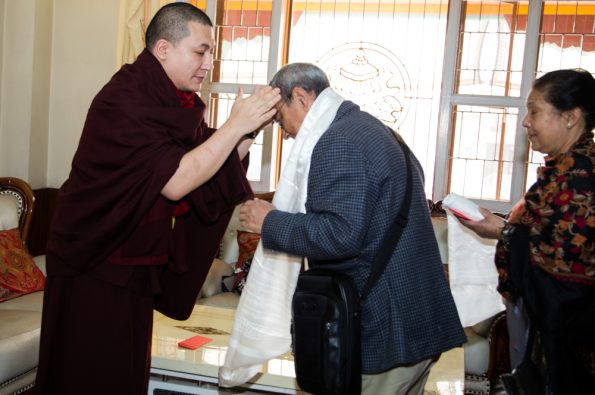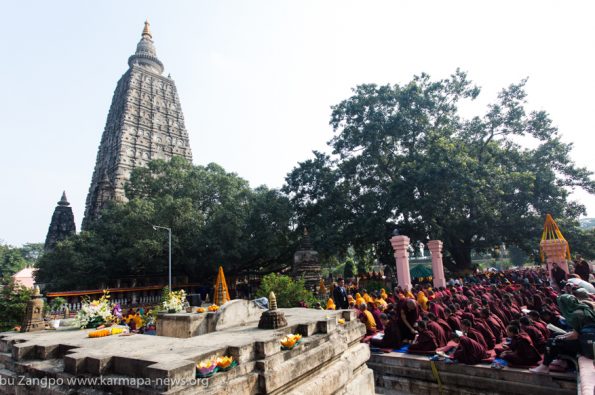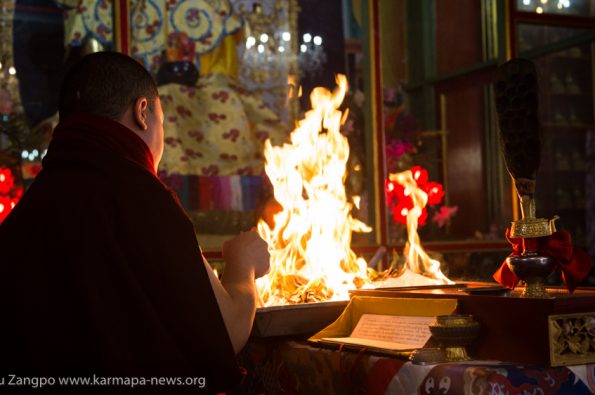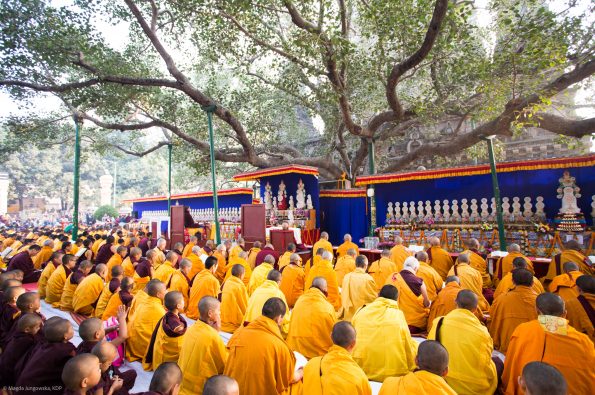Kagyu Monlam 2007
Bodhgaya, Kagyu Monlam 2007
Hoarse voices murmuring unintelligible mantras and wishing prayers; “Swash!” the gentle rhythms of prayer beads and prostrations; “Chirp, Chirp!” The birds sing along with squeaking mani-wheels as an old woman casts her body to the ground joining the soft chorus of babble; an assembly of people of every agegroup representing every corner of the globe circumambulate India’s most impressive monument to enlightenment, while others gaze softly yet fervently in quiet admiration and with genuine aspirations.
The Mahabodhi Stupa in Bodh Gaya may well be the most important Buddhist pilgrimage site in the world. The location in Bihar, India is said to be the exact spot where Siddhartha Gautama, over 2,500 years ago, attained the supreme enlightenment of a Buddha. The Stupa itself was erected around 250 BC by the great emperor Ashoka, a once notoriously violent ruler who converted to Buddhism during his reign after seeing the affects of his violent ways and, thus, devoting the rest of his life to the preservation and propagation of the Buddhist Dharma.
Since the Chinese occupation of Tibet, many Tibetans have migrated west to the birthplace of their faith. While living in Tibet, it was common to have an annual prayer gathering called “Monlam Chenmo”. This was a tradition started by the great Buddhist patriarch Je Tsong Khapa in the 15th century and was carried out up to the Chinese cultural revolution, when it was banned by the newly established communist government. Once in exile, many Tibetans sought refuge in India, finding themselves in the unique position, for a Tibetan, of now being able to easily visit the most holy places associated with the life of Lord Buddha. After some time, the tradition of the Monlam Chenmo was continued in exile and, of course, the Mahabodhi Stupa in Bodh Gaya became one of the most popular locations to revive such an event. These days, Monlam Chenmos have become common place in Bodh Gaya.
This year His Holiness the 17th Gyalwa Karmapa Trinley Thaye Dorje led the Monlam prayers for world peace and liberation for all sentient beings on Nov 10th through the 14th at the Mahabodhi Temple in BodhGaya. From all over the world people gathered to recite prayers, particularly the “King of Aspiration Prayers”, with His Holiness Karmapa, His Holiness Shamarpa and numerous other prominent Rinpoches and dignitaries from monasteries and Dharma centers of the Kagyu order throughout Europe, Asia and the Americas.
Preparations were made days in advance by the attending monks.Copious amounts of Tormas (offering cakes) and ritual objects were positioned in their rightful places while ceremonial provisions were being made to lay the holy foundation of this great prayer festival. Lama dances and pujas were performed in the days leading up to His Holiness’ arrival, which was on the eve of the festival’s official commencement.
On the morning of the10th of November, 2007, His Holiness Karmapa initiated the ceremonies. Karmapa Thaye Dorje entered the premises that cool autumn morning and circumambulated the Stupa at 7am. As the congregation began to swell, He then went to the holy places of the temple and paid his most humble respects to the Lord Buddha before taking his position under the Bodhi tree amongst the thousands of well-wishers gathered to make “aspiration prayers dedicated to increasing world peace, harmony and the happiness of all sentient beings.” His Holiness would do this every morning, during the five days of puja, in addition to giving instructions and commentary on the depth and innermost meaning of the Arya Bhadra Charya prayer of Samantabhadra in the evenings.
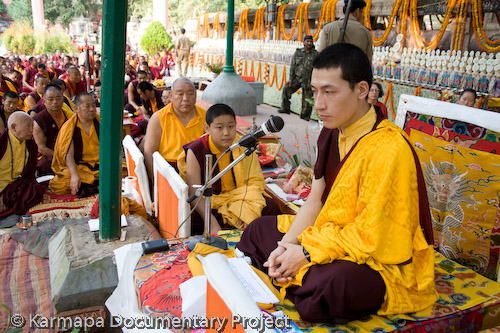
17th Karmapa teaching during Kagyu Monlam 2007
When His Holiness Karmapa was not at the Stupa, he offered his freetime to the multitude of devotees who had traversed many miles to participate in the Monlam. Amongst the visitors were a group of localschool children and faculty from the Free Siddhartha Children’s School,a school for underprivileged children in the area founded by one of the disciples of His Holiness Karmapa and His Holines Shamarpa. Karmapa Thaye Dorje met with each child giving them blessings and offering good advice to the faculty and student body.
His Holiness Karmapa was housed at Karma Tharjay Chokhorling, the Monastery of Beru Khyentse Rinpoche, where he took the opportunity to bless the newly constructed Mahakala room as well as preside over some auxiliary pujas at the monastery during and around the time of the Monlam. Breakfast was served for all in attendance in the morning while lunch was provided at Karma Tharjay Chokhorling, which is nearby the Mahabodhi stupa. His Holiness met with a continuous flow of people at the monastery. Group after group came, scarves in hand, to receive blessings and advice from the Karmapa during his down time from the Monlam.
The final two days (13th and 14th) of the event were doubly blessed, as His Holiness the 14th Kunzig Shamarpa had arrived and was joining in the morning prayers. On the evening of the 14th His Holiness Karmapa gave a “lung” for the Arya Bhadra Charya prayer of Samantabhadra. The final evening of the event, His Holiness Shamarpa gave a “lung” for Jamgon Kongtrul the Great’s commentary on the Seven Points of Mind Training. This coincided with a book that was being distributed written by theVenerable Shangpa Rinpoche on “Lo Jong” practice.
Among those in attendance during the 5 days of prayer were His Holiness the 17th Gyalwa Karmapa, His Holiness the14th Kunzig Shamarpa, H.E. Beru Khyentse Rinpoche, Jamgon Kongtrul Rinpoche and many other prominent Lamas and Rinpoches too numerous to mention.
Photos: Thule G. Jug









































































































































































































